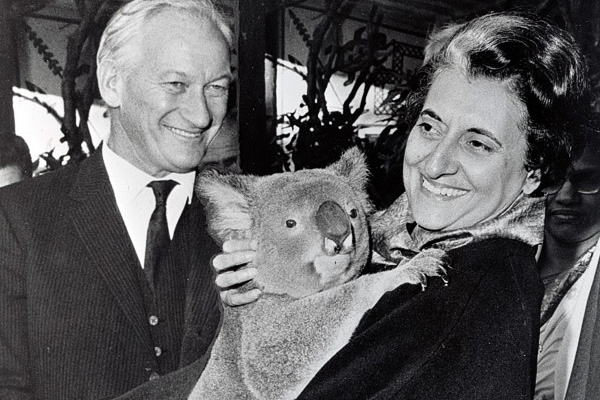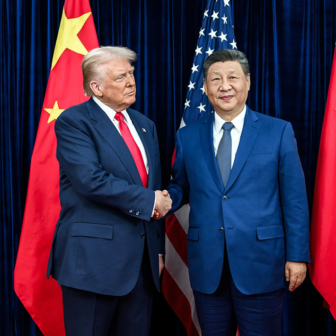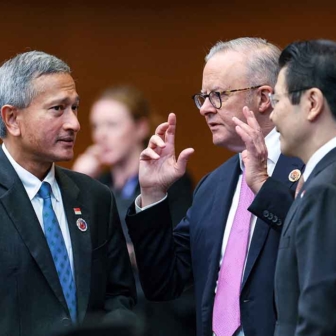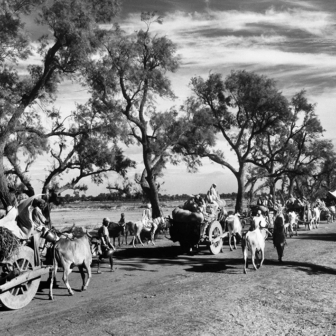Australia and India: Mapping the Journey 1944–2014
By Meg Gurry | Melbourne University Publishing | $37
It must be the iconic image of the Australia–India relationship. The year is 1968 and Indira Gandhi, the first Indian prime minister to visit Australia, is pictured with a girlish smile at Sydney’s Taronga Zoo. In her arms is a handsome koala, seemingly eager not to let its paws slip off her shoulders. Mrs Gandhi’s head is thrown back to accommodate the koala’s attentions, but it is clear that she is utterly enchanted. The Indian leader has found a part of Australia she can’t help but embrace.
Koala diplomacy is now a set piece in Australia’s welcoming of international dignitaries. But Meg Gurry’s multifaceted and impressively researched history of Australia’s bilateral relationship with what is now the world’s second-most populous country, Australia and India: Mapping the Journey, brings fresh context to the well-known “Indira with koala” press shot. For one thing, Gurry’s plumbing of the archives tells us that a week or so before the photo was taken, Mrs Gandhi’s request to take a koala back to India was summarily refused. For another, the book’s narration of the 1968 visit reveals it to be curiously devoid of substance, with nothing in particular tabled for bilateral discussion. The irony of the koala snap is that the one flicker of interest India had in Australia at the time – no matter how whimsical – was not fostered (although a koala was happily spared the need to travel).
Gurry offers an account of Australia and India’s flailing relationship that goes well beyond the clichéd tale of decades of neglect (with some cricket thrown in). In order to piece together a truly diplomatic history of the bilateral relationship, she has broken new ground in the National Archives, interviewed former high commissioners on both sides, and combed unpublished memoirs and papers. Gurry’s aim is to probe the “official mind” in order to access an otherwise hidden political realm, and that effort has proven a notable success.
Her method helps explain why a second photo of the koala episode, privately owned but housed in the National Library of Australia (and featured in the book’s own picture section, and above), reveals even more about the longstanding complexities of Australia’s relationship with India. The second smiling face in this other image is that of Sir Arthur Tange, high commissioner to India from 1965 to 1970. Tange professed to having spent “the best five years” of his life in India, and Gurry catalogues his impressive efforts to diagnose (and try to resolve) the roots of the diplomatic distance between the two countries.
Yet Tange is just one figure in Gurry’s stellar cast of Australian diplomats with a passion for India. Another is Walter Crocker, who served as high commissioner in New Delhi from 1958 to 1962 and felt confident enough to write a biography of India’s first prime minister, Jawaharlal Nehru. Crocker’s skill as an India-reader is evident in Ramachandra Guha’s celebration of that biography in the Monthly. But Crocker and Tange are not alone: Peter Heydon, Graham Feakes and John McCarthy are other standouts in Gurry’s “long line of dedicated high commissioners and diplomats who have worked hard to understand India.” Together, they deliver the freshest narratives and the keenest insights in her retelling of the Australia–India story.
In the process, Australia and India dispels the long-held official myth of Australia’s neglect of India. “Every leader since Whitlam,” Gurry notes, “has at some stage in their term of office ‘discovered’ India, spoken of the unfulfilled promise between the two states, and set out to forge and institutionalise a stronger bilateral connection.” And each leader’s quest, she concludes, has ended in “disappointment and frustration.” These efforts, along with the intelligence, insight and effort of many of Australia’s diplomats and high commissioners, show that neglect is not an accurate description of what is at fault with the relationship.
What, then, can Gurry tell us about what has gone so wrong, so often?
In line with the title, her book is structured as a journey, taking us on a chronological passage. As she makes clear, this is first and foremost a tale told through Australian voices, documents and worldviews, and the book’s major themes take Australia as their departure point. Australia is the primary agent, for example, in most of the political processes – including aligning, titling, searching and engaging – described in the titles of the seven chapters.
More unusually, Gurry also uses maps to pin down her narrative. In the book’s opening pages she argues persuasively that any understanding of the bilateral relationship is intimately entwined with its regional context. Maps count because “regions do not have fixed and predetermined boundaries – they are created, and their borders established and crafted in response to geopolitical events, to shifting alliances and to new trading and economic opportunities.”
Gurry’s pictorial maps speak the language any student of international relations and history would recognise: they offer clear visualisations of decolonisation, collective defence, multilateral groupings, economic cooperation, and the spread and containment of communism. The shifting boundaries of these maps (to include or exclude India) offer one kind of insight into the nature of change in the relationship. The conclusions to be drawn from them are the stuff of policy briefs, and Gurry lists them clearly in the conclusion. Shared strategic interests, economic links and people-to-people contact matter most in the relationship, and the recent upturn in Australia–India relations is tied to progress on each of these fronts.
But the book’s undrawn maps are by far the most compelling. These are the mental – and emotive – maps of race, civilisational hierarchy, moral conviction (largely regarding either the sanctity or malevolence of alliance diplomacy) and global status. Such maps show who matters most, and least, in global affairs, in Australian and Indian hearts and minds. By cultivating in the reader an understanding of these maps, Australia and India presents us with new lenses through which to interpret the relationship.
Seen through these lenses, some of the major obstacles to the India–Australia relationship come into keener relief. One is Indian disgust at the White Australia policy, which echoes in the ever-reigniting issue of race (most clearly seen in India’s angry response to the allegedly racist attacks on Indian students in 2009 and 2010). Another is Australia’s commitment to alliance diplomacy, manifesting as a routine adherence to US foreign policy priorities that Indian leaders often saw as weak and unimaginative. A third is Australia’s repeated relegation of India to a lower order of significance. This stemmed partly from a tendency of some Australian prime ministers to peer across Asia towards Europe and the West. Worse than that, in India’s eyes, it has also been clear in Australia’s tendency to ignore India and gaze instead at China. Or even worse than that, to turn away from India and towards Pakistan.
All of this is not to suggest that clashes in material interests have been irrelevant. In a replay of the koala snub, India’s keenness to buy Australia’s uranium and the Rudd government’s decision to block its sale in 2007 was a major sticking point. But clear, substantive issues of disagreement have been few. This is why Gurry’s more subtle mapping of the long-ranging value clashes within the relationship is so enlightening.
As well as the obstacles, the mental maps help us to understand the successes, too. There was a brief period in the early 1970s, for example, when Australia’s flash of independent foreign policy on the issue of Bangladesh met with Indian gratitude. Around the same time, the Whitlam government’s dismantling of White Australia earned that leader an invitation to visit India. More recently, the Howard government did well to recognise that India was finding a place at the heart of the world economy, while Tony Abbott has had the foresight to label India “the emerging democratic superpower of the world.” Perhaps more than any other diplomatic step, Australia’s greater recognition of India’s global importance has appealed to India and its sensitivities about status.
The book’s concluding section could do more to pull out revelations from the undrawn maps, and to sing more proudly about the fine contribution it makes to our understanding of Australian diplomatic history. At the broadest level, Gurry’s account is of an Australia seeking to find a place in Asia and the world. At the institutional level, it is one of the competing visions and values pursued at different moments by the political and bureaucratic arms of Australia’s diplomatic machine. And at the level of individual men (and occasional women) it is about an Australian capacity to deeply admire India and Indians and to use that (often unreciprocated) admiration as a mirror in which to assess Australia’s failures and omissions in policies of many kinds.
But much of the Indian story still remains tantalisingly out of reach. For Australia, Gurry observes, “it has always been an uphill battle to get India’s attention.” Why this is so is a story still waiting to be told. Australia and India is not quite the “definitive account of bilateral relations,” as Amitabh Mattoo of the Australia India Institute (and the book’s key backer), suggested earlier this year. But it is a credit to Gurry’s compelling and comprehensive treatment of the Australian side of the story that the reader is left thirsty for a parallel delving into Indian geo-strategic hang-ups, institutional complexities and individual flashes of diplomatic creativity.
At some levels, the Indian tale is likely to look remarkably similar. As a product of European empire – though of a very different kind – caught between Asia and the West, India too suffered a crisis of international identity in the early decades of independence as it implicitly sought recognition from major Western powers, even while championing Asian solidarity. While internationally, India spoke up against racism of all kinds, particularly on the issue of South African apartheid, the kinds of racial and civilisational hierarchies implicit in the White Australia policy were not entirely absent domestically, as Itty Abraham has shown in relation to early official discourse on India’s “backward and indigenous” peoples. But there will be major differences, too. Unlike Australia, India has stubbornly pursued a largely autonomous foreign policy for much of its independent history. Also unlike Australia, India’s global ambitions have almost always exceeded those of a middle power. With Indian sights set so high, Australia is likely to remain, as Gareth Evans described it to Gurry, of “second-order importance."
For the policy-maker looking for a way to patch over this mismatch in global ambition, one final insight from Australia and India should be pencilled down: Australian soft power can work temporary wonders, especially where that softness celebrates Indian achievements or takes Indian sentiments seriously. Julia Gillard’s bestowal of an Order of Australia on India’s best-loved cricketer, Sachin Tendulkar, was well-received, as was Tony Abbott’s symbolic return of two stolen Indian idols that came into the possession of Australian galleries. But, as Gurry shows, these gestures come rather late in the piece. Looking back to the iconic image of Indira Gandhi’s visit in 1968, Australia could have tried harder, earlier. Perhaps one of Sir Arthur Tange’s contemporaries should have packed that koala a suitcase. •




